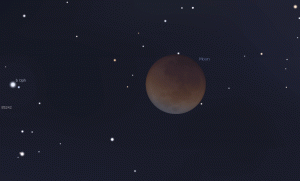A Total Lunar Eclipse will occur on the morning of Thursday 16 June 2011. The total eclipse begins at 5.22am AEST when the Moon totally enters the Earth’s shadow. Mid-eclipse occurs at 6.13 am AEST and the total phase ends at 7.02 am AEST. Twilight and then daylight will prevent residents of Eastern Australia from seeing the end of the Total phase of the eclipse. Residents of Western Australia will be able to see the Total Lunar Eclipse in its entirety.
The Total phase of this eclipse will last 100 minutes and be the longest eclipse since the one in July 2000. Sky & Telescope has an interesting article on why this eclipse is so long here. Keep in mind when you read the article that it is written for a Northern hemisphere audience.

A Lunar Eclipse can only occur when the Moon, Earth and Sun temporarily align. This almost occurs every month and coincides with the time of Full Moon. However, an eclipse doesn’t happen each month because the orbit of the Moon is tilted approximately 5 degrees relative to the plane in which the Earth orbits the Sun. This means that the Moon usually passes above or below the Earth’s shadow and there is no lunar eclipse. This year two lunar eclipses occur: one on the morning of Thursday 16 June and the second on the evening of 10 December 2011.
Total Lunar Eclipses can be quite dramatic. Casual skywatchers may expect that the Moon would merely darken and take on a dark grey appearance during a Total Lunar Eclipse. However, the Moon actually takes on a dark orange or even in extreme cases a dark ‘blood’ red colour (if there is a lot of volcanic dust in the Earth’s atmosphere). This is caused by the Earth’s atmosphere bending light into its shadow. Blue light is scattered easiest and doesn’t make it into the Earth’s shadow. Red light is scattered least and is bent most into the Earth’s shadow. Hence, the Moon takes on an orange or reddish appearance during a Total Lunar Eclipse.
All residents of Australia have to do to observe the Total Lunar Eclipse is look above the Western horizon before twilight begins on Thursday 16 June 2011. Any time after 5.22am would be ideal. The eclipse will be easily apparent to the unaided eye. How orange or red the eclipse will be is impossible to predict until the eclipse occurs. Both the Eyjafjallajökull volcano in Iceland and the Puyehue-Cordón Caulle volcano in Chile have injected significant amounts of dust into the Earth’s atmosphere potentially making this Thursday’s Total Lunar Eclipse the reddest for some time. Exact timing information for the eclipse can be found on NASA’s Solar and Lunar Eclipse website.
thanks, Paul, that’s exactly what I was looking for :o)
Glad you found the information helpful.
Regards,
Paul Floyd.